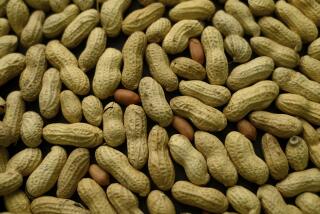With children and food allergy diagnoses, thoroughness is key

- Share via
More and more kids these days seem to have food allergies, and peanut-free classrooms are becoming the norm in many elementary schools.
In trying to characterize the apparent increase, scientists have identified two distinct trends. The first is that food allergies really are on the rise; the second is that they are often misdiagnosed.
Recent estimates say about 4% of children up to age 18 have food allergies. A study published last year in the journal Pediatrics examined trends in reported rates and found that the prevalence increased by about 18% from 1997 to 2007. Doctor visits and hospitalizations related to food allergies were also on the rise.
But it turns out that only about a third of people who say they have food allergies really do, says Dr. Amal Assa’ad, a pediatrician and allergy expert at the University of Cincinnati.
Concerns about misdiagnosis led the National Institute of Allergy and Infectious Diseases to commission a comprehensive review of the scientific literature by a panel of experts. Their guidelines, targeted to healthcare professionals, were released this month.
The bottom line is that diagnosis of food allergies must include more than a simple skin-prick test or a blood test, which is what many doctors have relied upon.
Here’s a closer look at food allergies in kids.
What are the most common foods for triggering allergies in kids?
Eggs, milk, soy, wheat and peanuts account for more than 90% of allergic food reactions in children, according to the American Academy of Family Physicians. (In adults, it’s shellfish, tree nuts, peanuts and fish.) It’s not uncommon to be allergic to more than one type of food.
Babies and children are more likely to have food allergies if they or a family member has had food allergies or other allergic conditions such as hay fever, asthma and eczema.
What are the symptoms of food allergies?
Allergic reactions to food can occur in the skin, the gastrointestinal tract and the respiratory tract. “Eighty percent of patients have some skin symptoms,” says Dr. Maria Garcia-Lloret, a pediatric allergist at UCLA’s David Geffen School of Medicine. This may be a reddish flush or actual hives or welts.
Gastrointestinal reactions include abdominal pain, cramping, vomiting and diarrhea. Respiratory symptoms may include wheezing, coughing or swelling in the throat.
How do doctors diagnose food allergies?
Allergic reactions have been assessed with skin-prick tests and blood tests, both of which look for sensitized immune reactions to specific food substances. For example, in a skin test, if a rash develops soon after applying a little milk with a prick, that’s considered evidence of a sensitized response to milk. A blood test looks for specific antibodies to milk proteins.
However, a sensitized response is not enough to make a diagnosis of milk allergy — it’s only one small part of a host of reactions that make up a food allergy, says Assa’ad, who served on the institute’s expert panel. As food is digested in the gut, it can become less allergenic. In addition, other immune factors in the body may counteract those sensitivities.
That’s why the panel emphasized that skin and blood tests alone are not sufficient to diagnose food allergies. The history of symptoms — does a child always get a rash when she drinks cow’s milk? — must also be taken into account.
The gold standard for diagnosis is an actual food challenge in the presence of a healthcare provider.
Can food allergies be prevented?
In a word, no. The causes of food allergies are not at all clear, although allergic diseases — including asthma, eczema and hay fever — tend to run in families.
“There are lots of studies on what you can do to reduce the chance of developing food allergies, but you can’t prevent them,” says Dr. Wesley Burks, a pediatric allergy expert at Duke University Medical Center in Durham, N.C.
Advice has varied over the years about how to reduce the risk for children. The American Academy of Pediatrics changed its official recommendations regarding interventions to reduce food allergies in babies in 2008 after a group of experts, including Burks, examined the scientific evidence.
Breast-feeding for at least four months does appear to have a protective effect against allergic reactions in general, although the data regarding specific food allergies are few. However, other dietary advice — such as delaying the introduction of foods like peanuts and eggs until babies were at least 1 year old to lessen the odds of an allergic reaction — did not hold up. Also, pregnant and breast-feeding moms are no longer told to avoid potentially allergenic foods.
Can kids outgrow food allergies?
Many food allergies wane over time, says Burks. Among the most commonly troublesome foods, kids are most likely to outgrow allergies to cow’s milk, eggs, wheat and soy, he says. Allergies to peanuts, fish and tree nuts are more likely to stay with them.
What should I do if my child has a reaction?
An epinephrine injection is the best remedy for an allergic reaction to food.
Antihistamines or steroids may be helpful to diminish lingering symptoms, but they are considered adjuncts to epinephrine, Assa’ad says. Because there’s no way to tell which child will have a potentially life-threatening reaction to a food, whoever is treating a patient should be prepared for the worst.




